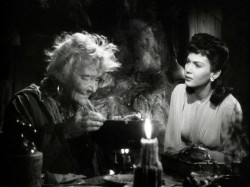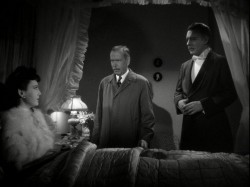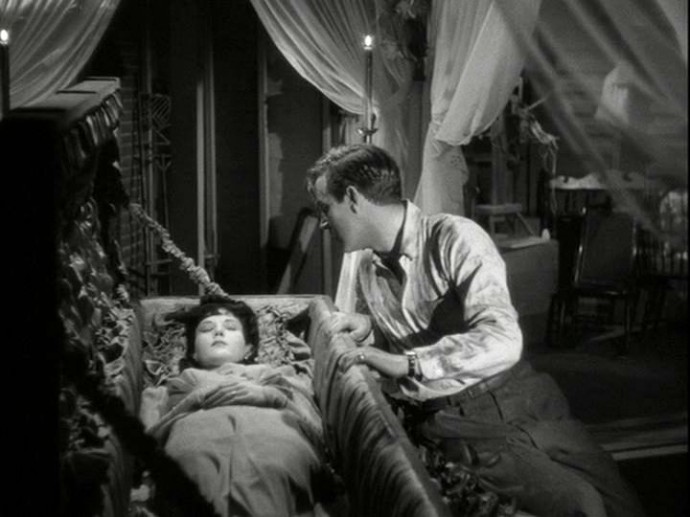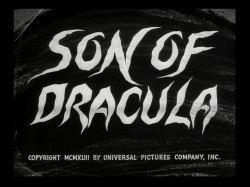Robert Siodmak’s Son of Dracula (1943) is a film that, but for one thing, would be one of the great horror pictures. Unfortunately, that one thing is a badly miscast lead—Lon Chaney Jr.—as Dracula, or, if you prefer, his son, and that’s a pretty big problem. (For kicks, you can always start a rip-roaring horror-fan fight by asking which he is.) The fact is that even at 61, Bela Lugosi would have pushed the film into greatness. Instead, we get uber-American cornfed Lon, who has trouble with the stylized dialogue (“I, too, thought I heard something in the cellar”), mispronounces words, and generally has no presence. It’s obvious that Siodmak knew this, because he shoots him from the back whenever possible. Even so, this moody, atmospheric film—a morbid fairy tale, actually—is probably the best of all second-wave Universal horrors. It’s all about a spooky, death-and-occult-fixated woman (Louise Allbritton) who brings Count Alucard (spell it backwards) to her plantation home in the Deep South for the express purpose of obtaining immortality, vampire style—something her jilted fiance (Robert Paige) and practical-minded sister (Evelyn Ankers) find peculiar, to say the least. The supporting cast, the direction and the musical score help, but Chaney is a serious stumbling block.

Several things are unusual about Son of Dracula—starting with the film’s opening credits where hands brush away cobwebs and dust to reveal the main title card, which recalls the very earliest days of Universal horror by replicating the main title on Paul Leni’s The Cat and the Canary (1927). In itself, this seems to signify a return to the more stylized horrors of the first wave—and the film delivers this more than any other 1940s film. This is very much a director’s movie where just about everything is subservient to style. The unfortunate thing is that it’s also the only outright horror picture that Siodmak made. The only thing remotely comparable is The Spiral Staircase, and that not exactly horror—and while it’s a better film, it’s not as interesting as this.

The film has the slickness of the 1940s product, but without the assembly-line feel of the movies that surround it. Generally, this works, though occasionally the payoff is undermined by—yes, Chaney. The elaborate tracking shot (courtesy of Universal’s “Broadway crane”) that introduces Dracula/Alucard is a perfect example. The shot begins looking through the window of the plantation at a dance in full sway. The camera pulls back slowly across the porch and out into the grounds—the dance music giving way to an eerie organ piece (that almost sounds like something out of a radio play)—and then angling down onto Dracula, who turns his head to actually look at the camera as if it’s an intruder. It would have worked with Lugosi. Not so much with Chaney.

Mostly, however, the atmosphere overrides this one casting problem. The small town swampland setting is marvelous—even more so because of its studio-bound unreality. There’s an agreeable melodamatic air to scenes like Allbritton’s visit to the swamp shack of her pet mystic Queen Zimba (the divine Adeline DeWalt Reynolds), especially with the old gal scared to death by the studio’s most ambitious fake bat. (It’s probably the best bogus bat the movies ever came up with, and, boy, does the movie get the good out of it.) A scene of Dracula’s coffin rising from the swamp waters with Dracula materializing from vapor and gliding across the swamp is one of the most accomplished bits of poetic horror you’re likely to see.

The casting—apart from Chaney—is effective and a little odd. Louise Allbritton and Robert Paige (the latter a kind a low-rent John Payne) were Universal contract players, but not associated with the genre. Allbritton—in a black wig—has the role that would normally have gone to Evelyn Ankers, who is here sideline to a supporting part. It works, though, and Paige’s tragic hero is one of the most interesting and effective in classic horror. Normally, it’s hard to work up much sympathy for the heroes in these movies, but Paige brings genuine pathos to the film. Bringing in Frank Craven (the venerable stage and screen “stage manager” of Our Town) adds just the right air of small town credibility—and Craven is a good enough actor to pull off such obvious material as figuring out the Alucard/Dracula “mystery.” J. Edward Bromberg’s Prof. Lazlo is a reasonable Van Helsing clone—and amusingly on the “I knew it all along” side.

The grim story works all the way, though the big confrontation between Dracula and Paige is where the Chaney casting really pulls things down. Chaney’s reaction to finding he has a blazing coffin—“Put it out! Put it out, I tell ya’!”—is so dreadfully American that…well, it’s more amusing than not. The film’s actual last scene, however, is handled with such gravity and such a sombre tone (unlike anything else of its era) that it lingers in the mind more than Chaney’s acting. One question, though—why does Dracula keep chickens in the cellar?




Good review. It is an atmospheric and moody film, which is its saving grace. And I bought Lon Chaney as the ‘son of Dracula’ about as easily as I bought him as the ‘son’ of the diminutive Sir John Talbot in ‘The Wolfman’.
Personally, I liked Chaney’s turn as a Bayou drunk in ‘The Alligator People’ about as well as anything he did (along with his role in ‘Spider Baby’).
And I bought Lon Chaney as the ‘son of Dracula’ about as easily as I bought him as the ‘son’ of the diminutive Sir John Talbot in ‘The Wolfman’
I can believe that Lady Talbot had a thing for the gardener or the milkman, though. As a kid, the height thing in The Wolf Man never bothered me. Lon as Dracula did.
Personally, I liked Chaney’s turn as a Bayou drunk in ‘The Alligator People’ about as well as anything he did (along with his role in ‘Spider Baby’).
Objectively, yes. I do still like him in Man Made Monster and I like his spoofs of Lennie in My Favorite Brunette and Casanova’s Big Night. That said, the big ox was so much a part of my Shock Theater childhood that I can’t generally be that hard on him.
Somewhat mystifyingly, this had a huge turnout and the audience — apart from some not intended, but perfectly understandable, laughter — was quite positive. We did have one of those completely inexplicable — to me — instances of someone sitting through 75 minutes of an 80 minute movie and then walking out. I simply don’t get that.
Glad there was a good turnout.
SON OF DRACULA’s an excellent film with a powerful vampire figure (who gets a lot of real closeups, not just from the back). I believe this guy when he effortlessly throws Robert Paige through the doors. Until this film, vampires had been fairly wimpy — and would be again until Hammer showed up. Sure, there are a few iffy line readings, but Chaney is, on the whole, fine in the part. (Remember, in the novel, Dracula seeks to speak like the locals so as to blend in; perhaps he occasionally botches his American pronunciation.)
I won’t even mention the Irish Southern sheriff. Ooops.
Makes sense, too, that an aristocrat’s going to be a wee zaftig, considering he’s spent hundreds of years feeding off the proles. As the dialogue says, his land’s dried up. America and its well-fed munchies are perfect drive-through snacks for Jabba the Leech. His fellow countryman Lazlo has certainly grown chunky in the New World.
I don’t think the film’s so much about the vampire, but about why we *want* vampires in our lives. Turn the ultra-blond and sunny Allbritton into a raven-haired morbid dreamer and she’s the spiritual ancestor of Anne Rice and all her followers.
My only real criticism with the script is that it never puts Claire (Ankers) in any peril. Might have upped the excitement quotient if she was more than a bystander.
As for the chickens, perhaps they’re something left over from Kay and Queen Zimba’s voodoo rituals. Or perhaps they’re fodder for the Count’s scientific experiments in which he seeks the perfect recipe that will launch his chain of Dark Oaks Fried Chicken restaurants.
Pee ess: I see you’re still misquoting Chaney. The line is, “Put it out! Put it out, do ya year me?”
with a powerful vampire figure (who gets a lot of real closeups, not just from the back).
Yes, well…Actually, the most common post-movie observation was that the film worked because it kept Chaney off-screen so much.
I believe this guy when he effortlessly throws Robert Paige through the doors.
But he doesn’t. He just kind of shoves him. I believed it more when Lugosi lifted Dwight Frye off the floor with one hand. This, after all, is a supernatural being. There’s no reason he should look like a luchador.
(Remember, in the novel, Dracula seeks to speak like the locals so as to blend in; perhaps he occasionally botches his American pronunciation.)
Well, citing the novel has never impressed me, but even if that enters the picture, if you’re trying to blend in, why are you going to wear dinner clothes and an opera cape in the rural south?
As for the chickens, perhaps they’re something left over from Kay and Queen Zimba’s voodoo rituals. Or perhaps they’re fodder for the Count’s scientific experiments in which he seeks the perfect recipe that will launch his chain of Dark Oaks Fried Chicken restaurants
I’ve suggested the last before, but it doesn’t explain the feathers all over the floor of his coffin. That looks more like he likes to take one to bed with him where he pets him and strokes him until “he don’t move no more.”
The line is, “Put it out! Put it out, do ya year me?”
I concede the mistake, but the real line is no less funny. It was demonstrated last night with an audience.